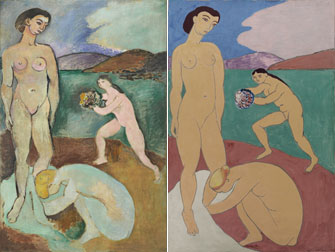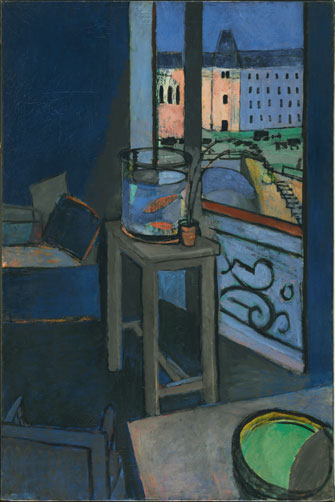Two Matisses Are
Better than One

Matisse’s: ”Le Luxe I” and Le Luxe II” (both 1907). © Succession H. Matisse
“Not another Matisse exhibition!” you may be thinking. It’s true, the man gets a lot of coverage, but don’t forget that he lived a long life (1869-1954) and was a hard-working, prolific artist. And, as a friend I ran into at the opening said, “You just feel happy when you look at his paintings.”
The new exhibition at the Centre Pompidou, “Matisse: Pairs and Series,” shows just how hard-working he was. Never satisfied with a piece, he often made multiple versions of the same subject. The show starts off strong with two beautiful still lifes from earlyish in his career (1898-99): one of oranges, with a simple composition and flat treatment of the fruit in Fauve-like colors, and the other of apples and oranges, which has that densely patterned background so typical of Matisse and shows the influence of Cézanne in the roundness of the fruit.
When he lived in Paris between 1894 and 1905, Matisse often painted the views from his window. We see three versions of his view of the Pont Saint Michel, painted in 1900-01: one in muddy colors with a great deal of detail; another in bright colors with a flat treatment and little detail; and the third, which appears to be unfinished, in a pointillist style.
In another view of the Seine, this time in the direction of Notre Dame, Matisse used two very different treatments in the paintings shown here, both dating from 1914. One is fairly realistic, while the other, painted in gorgeous blues with touches of black and green, reduces the towers of the cathedral to two simple blocks and eliminates almost all detail except for the lines of the quays and bridge.
Also painted in 1914, “Intérieur, Bocal de Poissons Rouges” is hard to beat for sheer tranquil beauty. Those wonderful purplish Matisse blues are complemented by the

Matisse’s: “Intérieur, Bocal de Poissons Rouges” (1914). © Succession H. Matisseglowing pinkish light – picked up and intensified by the orange goldfish in their bowl – on a building across the river, seen through the window, with its typically Parisian wrought-iron railing. Its companion work, “Poissons Rouges et Palette,” zooms in on the goldfish bowl in front of the window and ignores the outside world.
The exhibition also includes long series of drawings that show just how obsessive Matisse was about reworking the same subject over and over again – the secret to the wonderful economy of line he finally achieved? “At each stage,” he said in 1936, “I find a balance, a conclusion. During the next session, if I find a weak spot in the work, I go back into the picture through the weak spot and reconceive the whole thing.”
The exhibition also serves as a nice overview of Matisse’s long career, with well-selected works from different periods, painted in different places: Paris, Seville, Tangiers, Saint Tropez, etc.
In 1913, Matisse said, “When I am working, I try not to think, just to feel,” good advice for artists working in any discipline, and for visitors to this show.
So, yes, another Matisse exhibition. Go, and be happy.
Centre Pompidou: 19, rue Beaubourg, 75004 Paris. Tel.: 01 44 78 12 33. Open 11am-9pm. Closed Tuesday. Métro: Rambuteau. Admission: €12. Through June 18. www.centrepompidou.fr
Reader Michael Barker writes: “A delightful review. Small points: one might get the impression that he only lived in Paris early on but in fact his flat (after his wife left him) in an Art Deco building in the Boulevard de Montparnasse is still occupied by a member of his family and significant places in which he painted were missing: Collioure – birthplace of Fauvism, Nice (in which he lived for a long time) – which has an excellent Matisse museum – and Vence during his last years – where he created that sublime chapel. Not being picky but thought it worth mentioning.”
Please support Paris Update by ordering books from Paris Update’s Amazon store at no extra cost. Click on your preferred Amazon location: U.K., France, U.S.
Reader Reaction:Click here to respond to this article (your response may be published on this page and is subject to editing).
More reviews of Paris art shows.
© 2012 Paris Update
Favorite